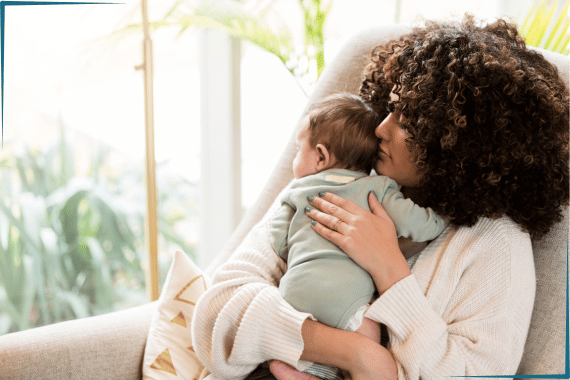Many parents think that sleep associations are always bad, but that’s not true.
Even as adults, we have our own sleep associations, such as darkness, our bed, our pillow, or maybe reading a book before going to sleep. The same goes for our little ones.
In this article, you’ll see that positive sleep associations can actually help your baby develop healthy sleep habits.
I’ll also sprinkle in some science behind these associations because, as a neuroscientist, I want you to understand why these methods work.
The Role of Sleep Associations in Babies
Below the age of 6 months, helping our babies to sleep (and back to sleep) with feeds, cuddles, rocking, patting, and contact sleeping is entirely normal.
We can try to encourage the development of self-soothing skills, but in general, I recommend doing everything on demand at this stage of development.
As their sleep develops and dramatically changes its structure (developing adult-like sleep stages), after 6 months, babies are absolutely capable of sleeping longer stretches of sleep without our help.
Yet they’re unlikely to do so unless and until we give them the opportunity to do so themselves, without us doing sleep for them.

Understanding the Science Behind Sleep Associations
Sleep associations are cues that our brain connects with the process of falling asleep.
For adults, this might include a specific bedtime routine or the feeling of our own bed. For babies, sleep associations work similarly. They help signal to the brain that it’s time to transition into sleep mode.
As a neuroscientist, I can tell you that these associations play a crucial role in promoting sleep and developing sustainable sleep patterns.
It may come as a surprise, but just like adults, babies wake up many times throughout the night after each sleep cycle. If their sleeping environment remains consistent with how it was when they initially fell asleep, these brief awakenings usually last only a few minutes, and they soothe themselves back to sleep without us even noticing.
However, if the conditions have changed—such as no longer being held, rocked, or needing a bottle or breast to fall back asleep—it can lead to difficulties and cause them to wake up frequently during the night.
The Problem with Negative Sleep Associations
While sleep associations are natural, some can become problematic over time.
Negative sleep associations, like needing to be rocked or fed to sleep, can lead to frequent night wakings, difficulty self-soothing, and inconsistent sleep patterns. This often results in poor sleep for both your baby and you, which isn’t good for anyone!
Over time, these associations can create a dependency where the baby cannot fall back asleep without the same conditions being recreated.

Positive Sleep Associations That Are Less Likely to Disrupt Sleep
Positive sleep associations, or cues, are essential for establishing sustainable sleep patterns.
These include pre-sleep rituals that signal to the body and mind that sleep is approaching, as well as associations that stay with your baby throughout the night, promoting consistent sleep.
Below is a list of positive sleep associations that can actually help with sleep consistency.
1. Pre-Sleep Associations: Bedtime and Pre-Nap Routine
These routines should be easily replicated by anyone, anywhere, at any time. Positive sleep associations day and night provide your baby with predictability, security, and the necessary wind-down time before bed. This can help promote self-settling and minimise bedtime resistance and night waking. Examples include:
- Bath Time: A warm bath before bed helps relax your baby’s muscles and calm their mind. The sensation of warm water can be soothing and signal that it’s time to wind down. Bath time also creates a consistent, predictable activity that your baby can associate with the transition to sleep.
- Reading a Story: Reading a calming bedtime story provides a gentle way to transition from the activities of the day to the calm of night. It engages your baby’s attention in a soothing way and helps establish a quiet, peaceful atmosphere. Stories can become a comforting ritual that signals bedtime and are a perfect bonding experience.
- Closing Blinds and Dimming Lights: Creating a dark environment by closing blinds and dimming lights helps signal to your baby’s brain that it’s time to sleep. Darkness prompts the release of melatonin, a hormone that regulates sleep-wake cycles. During naps, this environment mimics nighttime, encouraging your baby to feel sleepy.
- Gentle Massage: A gentle massage can be incredibly soothing for your baby. It helps relax their muscles and calm their nervous system. This tactile stimulation can reduce stress and anxiety, making it easier for your baby to transition into sleep. The consistent, loving touch also strengthens the bond between you and your baby.
- Sleepy Phrase from Parent: I encourage every parent I work with to come up with an easy, catchy sleep phrase that their little one can learn. Repeating a calming phrase each night, such as “It’s time for sleep, little one,” can be a powerful cue for your baby. This phrase, said in a soothing tone, becomes associated with the act of falling asleep. Over time, this verbal cue helps signal that it’s time to transition to sleep, promoting a sense of security and routine. In the long run, this phrase will become a powerful tool, providing additional comfort and verbal reassurance when needed.
2. Positive Sleep Associations That Stay Consistent Through the Night
These associations remain constant throughout the night, helping to promote uninterrupted sleep:
- Sleeping Bag: A sleeping bag can be a fantastic positive sleep association for your baby because it keeps them comfortable and secure throughout the night. Unlike loose blankets, a sleep bag provides consistent warmth and a cozy, enclosed environment, preventing them from waking up cold or uncovered. Since your baby stays in the sleep bag all night, it maintains consistent conditions, helping them feel safe and calm. Moreover, the routine of being placed in a sleep bag each night can signal to your baby that it’s time to sleep, further reinforcing a healthy bedtime routine.
- White Noise: White noise masks background noise and creates a constant, soothing sound environment. The steady hum can be similar to the sounds your baby heard in the womb, which is calming and familiar. White noise also helps drown out sudden noises that might startle your baby awake.
- Darkness: Darkness helps signal to your baby’s brain that it’s time to sleep. Exposure to light can interfere with the production of melatonin, the sleep hormone. Keeping the room dark ensures that your baby’s internal clock stays in sync with night-time, promoting deeper and more restful sleep.
- Comforter (for kids over 12 months): Items like a lovey or blanket can provide security and comfort and are examples of positive sleep associations. For safety reasons, it’s best to introduce these items after 12 months. A comforter can become a source of emotional support for your baby, making them feel secure and comforted throughout the night. This sense of security can help your baby self-soothe and fall back asleep if they wake during the night.
Encouraging Self-Soothing Skills
As babies grow, it’s important to gradually encourage the development of self-soothing skills.
This doesn’t mean leaving them to cry it out, but gently teaching them to fall asleep on their own. Start by putting your baby down awake. This helps them learn to associate their bed with the process of falling asleep.
Transitioning Away from Negative Sleep Associations
If you’re struggling with long bedtimes or multiple night wakings, there are gentle ways to switch from negative sleep associations to positive ones.
For example, if your baby is used to being rocked to sleep, gradually reduce the amount of rocking time over several nights. Instead, focus on the positive sleep associations listed above.
Remember, it’s always about switching one sleep association for another to create a healthier, more consistent sleep routine for your little one.
The Importance of Consistency
Consistency is key when it comes to teaching your baby to fall asleep without any additional help. Make sure that everyone involved in your baby’s care follows the same bedtime and pre-nap routines.
This predictability helps your baby feel secure and understand what to expect, which in turn promotes better sleep.
Conclusion
By incorporating these gentle and effective sleep associations, you can help your little one develop healthy sleep habits that lead to better rest for both of you. Remember, it’s a gradual process, and patience is crucial. With time and consistency, you’ll see positive changes in your baby’s sleep patterns.
I’m Olena, a founder of Caring Sleep Solutions. I’m a neuroscientist, and a Pediatric Sleep Consultant and Adult Sleep Coach, and most importantly, a mother who has experienced severe sleep deprivation. For more tips and insights on improving sleep for both you and your little one, follow me on Instagram.
If you’re struggling with your little one’s frequent night awakenings and short naps, check out my 1:1 support options. Together, we can gradually teach your baby to self-settle in a very gentle way, helping you both forget about sleepless nights.

